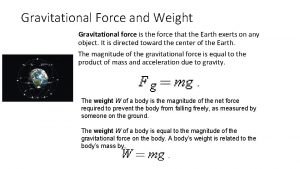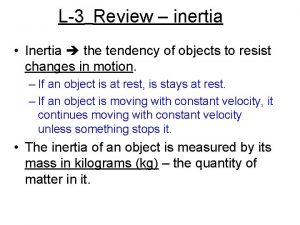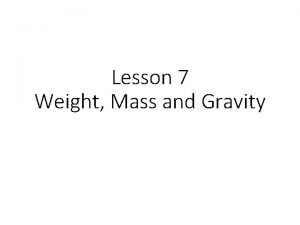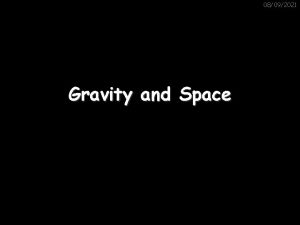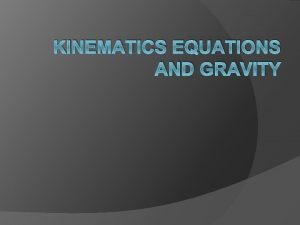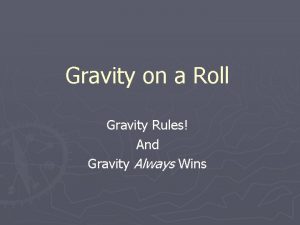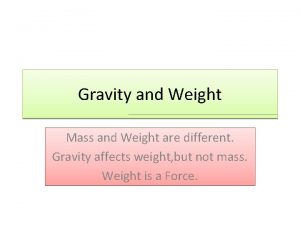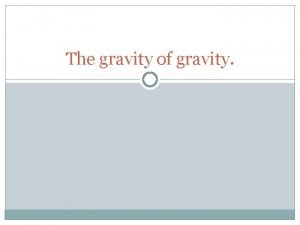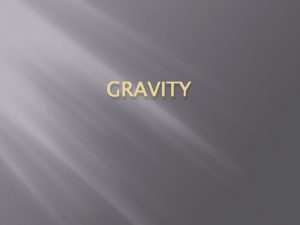Diving and Science Gravity and Weight Diving is











- Slides: 11

Diving and Science: Gravity and Weight

Diving is the sport of performing acrobatics whilst jumping or falling into water from a platform or springboard from a certain height. Historical artefacts tell us that people have been diving off high cliffs into water since ancient times. Modern diving, as we now know it, developed between the late 17 th Century and the early 19 th Century.

Diving It was the Swedes and the Germans who pioneered early techniques, turning diving into the global sport it is today. Diving made its first appearance at the Olympic Games in 1904 with the men’s 10 m platform event. The sport is not the most widely participated in but is very popular amongst spectators as the athletes demonstrate many of the same characteristics as gymnasts and dancers, including strength, flexibility, and technical ability.

Diving and how it links to science through gravity § Diving is possible because of gravity. § Gravity is an invisible force which pulls things towards the earth. § Gravity is the reason things fall. § Try dropping your pen from your hand. It doesn’t just float in the air, it falls towards the ground because of gravity.

Weight is actually a force and is measured in Newtons, not in kilograms and pounds, which are sometimes misused when referring to weight, and actually represent an object's mass. An object's weight can change depending on other forces acting on it. Gravity causes something to have weight on Earth; that same object may have a lesser weight on the Moon, for example. Weight is related to an object's mass and the gravity acting on that mass.

Different weights under different Gravitational situations The force of gravity on the Moon is less than on the Earth. This is why it appeared that astronauts could jump great distances on the Moon. To counteract this reduction of gravity lunar astronauts wear items with a bigger mass such as space or moon boots. If these were worn on Earth the astronauts would hardly be able to move about, let alone jump the great distances they do on the Moon.

Weight in water An object's weight does not change in water, even though it appears to do so. Water exerts a force upwards on an object placed in it. This force is known as up thrust. The up thrust of water is much greater than the up thrust of air and is why objects appear lighter in water. The up thrust of water is what slows a diver down, and eventually brings them back to the surface, when the diver enters the pool.

Worksheet answers – Q 1 & Q 2 1. What is the invisible force that pulls objects towards the Earth or causes objects to fall? The invisible force that pulls things downwards towards the Earth is gravity. 2. Weight is actually a force acting on an object. What is this force measured in? Weight is measured in Newtons

Worksheet answers – Q 3 3. Why can an astronaut take giant steps on the Moon and what do they do to overcome the reduced gravity they experience on the Moon? The force of gravity is weaker on the Moon than it is on Earth allowing astronauts to take much bigger steps or jump further before they are pulled back to the ground again. To try to overcome this space or moon boots, which have a very large mass, are worn. The increase of mass this provides effectively gives the spacemen more weight, as there is a greater mass for the gravity on the Moon to act on.

Worksheet answers – Q 4 4. Would it be possible for an astronaut to perform a more or less complicated dive on the Moon, if there was air and water present, or on the Earth? Explain your answer. If an astronaut could dive on the Moon, then they would be able to perform a far more complicated dive. This is because there is a smaller force of gravity acting on the diver, on the moon, meaning they would be pulled towards the ground more slowly than if they were on Earth. The extra time in the air would allow them to complete more twists, turns and somersaults and so a more complicated dive.

Worksheet answers – Q 5 5. Explain why objects appear to weigh less in water than they do in air. An object weighs the same in water as it does in air as it is experiencing the same gravitational force on it pulling it towards the centre of the Earth. Water produces an upward force, known as up thrust, against an object placed in/on it. This force can be strong enough to act against the downwards force of gravity causing the object to appear to have less weight than when in air. Air also produces an up thrust force on an object but this is far less than the force water produces.
 Gravity for dummies and dummies for gravity equations
Gravity for dummies and dummies for gravity equations Weight and force
Weight and force Physics 02-02 weight and gravity answers
Physics 02-02 weight and gravity answers Specific gravity of water formula
Specific gravity of water formula Weight equals mass times gravity
Weight equals mass times gravity Pharmaceutical application of specific gravity
Pharmaceutical application of specific gravity Examples of bulk gaining industry
Examples of bulk gaining industry Tolerable weight is a body weight
Tolerable weight is a body weight Whats your favorite subject
Whats your favorite subject Gravity vehicle ramp
Gravity vehicle ramp Nfhs swimming and diving rules book
Nfhs swimming and diving rules book Atmospheric suits
Atmospheric suits

